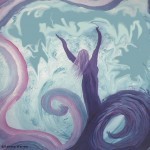Hope and Fear: Our Worst Enemies?
Writing and Art Reflections on Creativity, Life and Spirit
By Rahima Warren
HOPE AND FEAR: OUR WORST ENEMIES?
Most of us would agree that fear is one of worst inner enemies, keeping us from taking chances, moving forward—but hope? Doesn’t hope keep us moving, working to make things better? Yes, that’s the problem. Hope keeps us focused on the future, on striving to get the hoped-for reward. Fear keeps us always looking behind or around for the threat or danger. Unless there is a bear or a tiger actually roaring at us RIGHT NOW, fear comes from past experiences of harm, threat or insult. Neither hope nor fear allows us to settle into the present moment, which is the only place where peace, joy and love can be found.
“Hope and fear is a feeling with two sides. As long as there’s one, there’s always the other. This is the root of our pain. In the world of hope and fear, we always have to change the channel, change the temperature, change the music, because something is getting uneasy, something is getting restless, something is beginning to hurt, and we keep looking for alternatives.”
As I read this quote, I have several reactions. First, I get grumpy and grumbly. “Well, of course we want to be comfortable!” Then I get irritated. “Oh, stop! We’re only human. Of course, we have hopes and fears. How could we not in this crazy world?”
But then a sense of recognition sinks in. I know Pema speaks truth here. I remember seeing this myself. Somewhere in one of my journals, I drew a picture of me as a mouse in an exercise wheel, running and running, with Fear behind me snarling, and Hope before me smiling seductively, getting me absolutely nowhere. When I visualized jumping off the wheel, it was scary at first, then exhilarating. And then I landed in myself, in the present moment, in peace.
But how do we let go of hope and fear? Good question. Pema Chödrön is saying to look behind the fear or hope to the discomfort or uneasiness or pain underneath. To me, that means being present and aware of what is arising in us, and just noticing it with curiosity. Where did this discomfort come from? When did it start?
I’ve been feeling grumpy and out of sorts this morning. So let me sit with it and see where it goes. Okay, the first thing that comes up is that I got grumpy when I started dealing with my aging mother’s taxes, instead of writing. Next, a feeling of being overloaded with doing stuff other than what I truly want to be doing, out of a sense of duty and obligation. No wonder I get grumpy!
Phew! The grumpiness is subsiding, but now there’s some sadness. What’s this all about? Is it about my mother getting near the end of her life? Hmmm, that’s only part of it. What else? Is it because I’ve been abandoning part of myself? Ah, yes. Which part? Oh, the playful little girl and the wild woman who both love to be outdoors, dancing with the wind, walking quietly by a gurgling creek in the woods, spying a tiny orange flower or a lizard with an electric blue tail, smelling the bay laurel’s scent, watching a redtail hawk soar. Wow, now I’ve got it, and I feel better, clearer and more settled in.
As Ram Dass wrote, it’s all grist for the mill. Whatever arises needs attention and curiosity, rather than avoidance or soothing. Nothing necessarily has to change, except our inner responses. And these can shift toward peacefulness just from being recognized and accepted.
Contemplation Questions
How do you deal with Fear? With Hope?
Do they run you around in circles, or can you step off that “exercise wheel”?
How is it for you to sit with arising discomfort without judging, avoiding or soothing?
Does noticing what’s going on in you help shift you back to your peaceful center?





